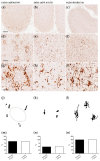Microglial Heterogeneity and Its Potential Role in Driving Phenotypic Diversity of Alzheimer's Disease
- PMID: 33803478
- PMCID: PMC7967159
- DOI: 10.3390/ijms22052780
Microglial Heterogeneity and Its Potential Role in Driving Phenotypic Diversity of Alzheimer's Disease
Abstract
Alzheimer's disease (AD) is increasingly recognized as a highly heterogeneous disorder occurring under distinct clinical and neuropathological phenotypes. Despite the molecular determinants of such variability not being well defined yet, microglial cells may play a key role in this process by releasing distinct pro- and/or anti-inflammatory cytokines, potentially affecting the expression of the disease. We carried out a neuropathological and biochemical analysis on a series of AD brain samples, gathering evidence about the heterogeneous involvement of microglia in AD. The neuropathological studies showed differences concerning morphology, density and distribution of microglial cells among AD brains. Biochemical investigations showed increased brain levels of IL-4, IL-6, IL-13, CCL17, MMP-7 and CXCL13 in AD in comparison with control subjects. The molecular profiling achieved by measuring the brain levels of 25 inflammatory factors known to be involved in neuroinflammation allowed a stratification of the AD patients in three distinct "neuroinflammatory clusters". These findings strengthen the relevance of neuroinflammation in AD pathogenesis suggesting, in particular, that the differential involvement of neuroinflammatory molecules released by microglial cells during the development of the disease may contribute to modulate the characteristics and the severity of the neuropathological changes, driving-at least in part-the AD phenotypic diversity.
Keywords: Alzheimer’s disease; Aβ; MMPs; chemokines; cytokines; dementia; heterogeneity; innate immunity factors; microglia; neuroinflammation.
Conflict of interest statement
The authors declare no conflict of interest. The funders had no role in the design of the study; in the collection, analyses, or interpretation of data; in the writing of the manuscript, or in the decision to publish the results.
Figures






Similar articles
-
Identification and therapeutic modulation of a pro-inflammatory subset of disease-associated-microglia in Alzheimer's disease.Mol Neurodegener. 2018 May 21;13(1):24. doi: 10.1186/s13024-018-0254-8. Mol Neurodegener. 2018. PMID: 29784049 Free PMC article.
-
Microglia, neuroinflammation, and beta-amyloid protein in Alzheimer's disease.Int J Neurosci. 2014 May;124(5):307-21. doi: 10.3109/00207454.2013.833510. Epub 2013 Sep 12. Int J Neurosci. 2014. PMID: 23930978 Review.
-
Fibrillar Aβ triggers microglial proteome alterations and dysfunction in Alzheimer mouse models.Elife. 2020 Jun 8;9:e54083. doi: 10.7554/eLife.54083. Elife. 2020. PMID: 32510331 Free PMC article.
-
Quantitative proteomics of acutely-isolated mouse microglia identifies novel immune Alzheimer's disease-related proteins.Mol Neurodegener. 2018 Jun 28;13(1):34. doi: 10.1186/s13024-018-0266-4. Mol Neurodegener. 2018. PMID: 29954413 Free PMC article.
-
Neuroinflammation in Alzheimer's Disease: Microglia, Molecular Participants and Therapeutic Choices.Curr Alzheimer Res. 2019;16(7):659-674. doi: 10.2174/1567205016666190503151648. Curr Alzheimer Res. 2019. PMID: 31580243 Review.
Cited by
-
The relationships between neuroglial and neuronal changes in Alzheimer's disease, and the related controversies II: gliotherapies and multimodal therapy.J Cent Nerv Syst Dis. 2022 Nov 14;14:11795735221123896. doi: 10.1177/11795735221123896. eCollection 2022. J Cent Nerv Syst Dis. 2022. PMID: 36407561 Free PMC article. Review.
-
How Many Alzheimer-Perusini's Atypical Forms Do We Still Have to Discover?Biomedicines. 2023 Jul 19;11(7):2035. doi: 10.3390/biomedicines11072035. Biomedicines. 2023. PMID: 37509674 Free PMC article. Review.
-
Spatiotemporal patterns of gliosis and neuroinflammation in presenilin 1/2 conditional double knockout mice.Front Aging Neurosci. 2022 Sep 14;14:966153. doi: 10.3389/fnagi.2022.966153. eCollection 2022. Front Aging Neurosci. 2022. PMID: 36185485 Free PMC article.
-
Recent update on the heterogeneity of the Alzheimer's disease spectrum.J Neural Transm (Vienna). 2022 Jan;129(1):1-24. doi: 10.1007/s00702-021-02449-2. Epub 2021 Dec 17. J Neural Transm (Vienna). 2022. PMID: 34919190 Review.
-
Special Issue "Microglia Heterogeneity and Its Relevance for Translational Research".Int J Mol Sci. 2021 Nov 16;22(22):12350. doi: 10.3390/ijms222212350. Int J Mol Sci. 2021. PMID: 34830232 Free PMC article.
References
-
- Morris J.C. Early-stage and preclinical Alzheimer disease. Alzheimer Dis. Assoc. Disord. 2005;19:163–165. - PubMed
MeSH terms
Substances
Grants and funding
LinkOut - more resources
Full Text Sources
Other Literature Sources
Medical

